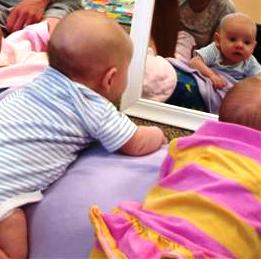Once your baby has mastered a solid sitting position, you’ll find that he is able to remain sitting upright and stable for longer periods of time. He is able to make subtle balance adjustments and may begin reaching for objects further out of reach.
Now that he doesn’t need to focus as much on keeping his body from falling, he can shift his attention to the important work of baby play. Like a little scientist, your baby will study his toys, how they feel, taste, look and sound.
Your baby will still mouth everything, but no longer is that his primary way to investigate an object. Instead, he’ll inspect toys carefully, using wrist rotation to turn it in different angles, and hold it with one hand to manipulate it with the other. Learning to use two hands in a coordinated fashion is a developmental task at this stage: watch your child stabilize the toy in one hand, and use the other hand spin, poke or explore the object. Using both hands differently to accomplish a goal is new and exciting.
In addition to more complex rattles, your baby is ready for more complicated developmental toys now. Stacking cups, nesting boxes, Tupperware containers and small blocks are excellent toys for this age group. Try placing an assortment of small but baby-safe toys or household objects in a plastic bowl or shoebox for your baby to explore. He’ll likely spend time removing objects one by one to empty the container. Show him how to put them back “IN” and take them “OUT” again. Your baby will also enjoy holding two objects, one in each hand, and banging them together. He may intentionally drop one object to pick up another and experiment with the different sounds he can make banging first one and then another object against another or against the floor or table.
Select open-ended safe developmental toys, meaning that you can play with them in different ways during different developmental stages. For example, your baby may not yet be ready to place blocks through the lid of a shape-sorting set, but he will enjoy using the blocks in other ways or just taking them out of the container. Keep your toy areas “fresh” by preventing your baby from being overwhelmed by a big pile or baskets of toys. Instead, put out a small assortment, and rotate the selection every few days. Have baby safe books available (washable fabric books or plastic “bath books” are good choices if your child tends to chew on board books) and keep board books handy in every room so you always have a book in reach to read to your baby when the opportunity arises.

